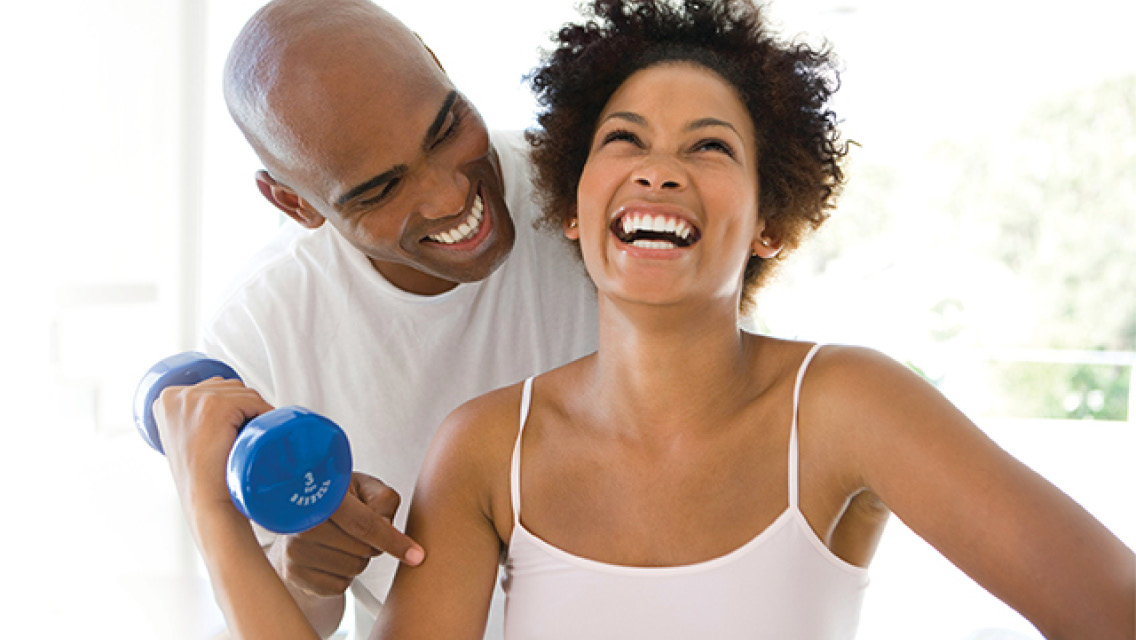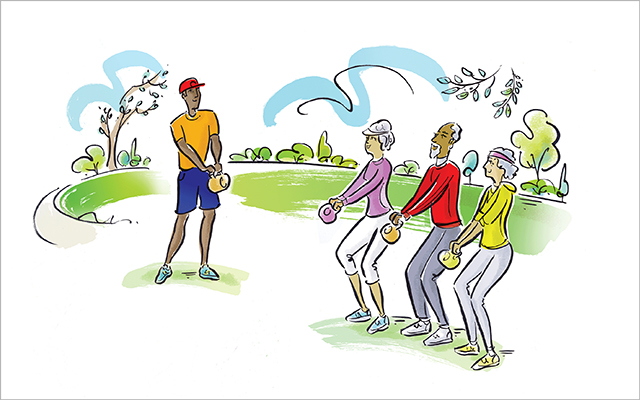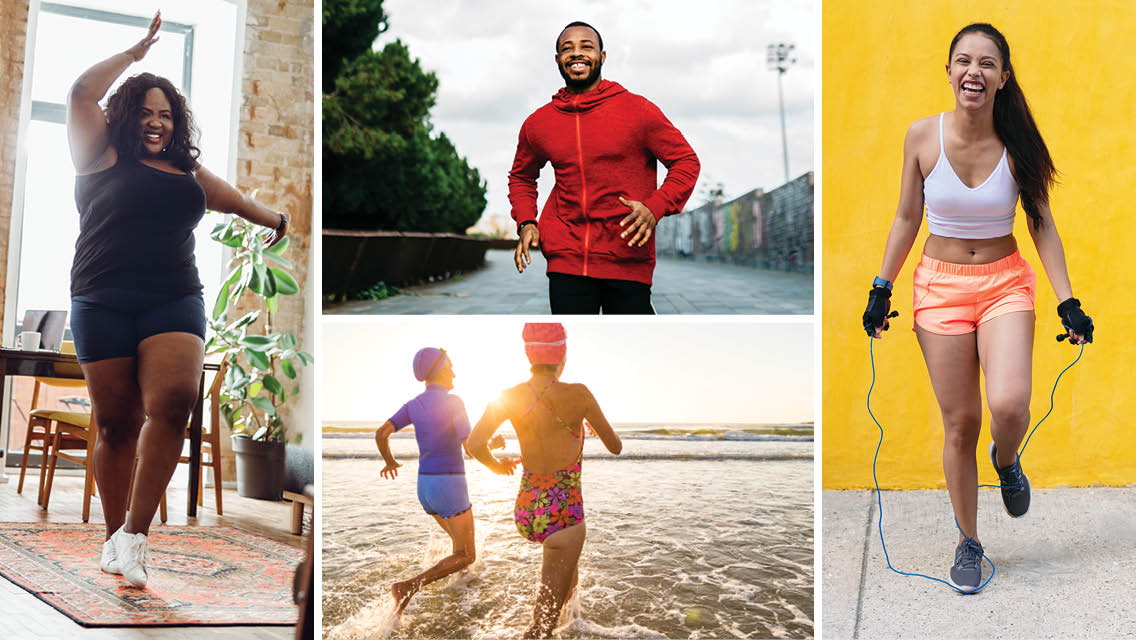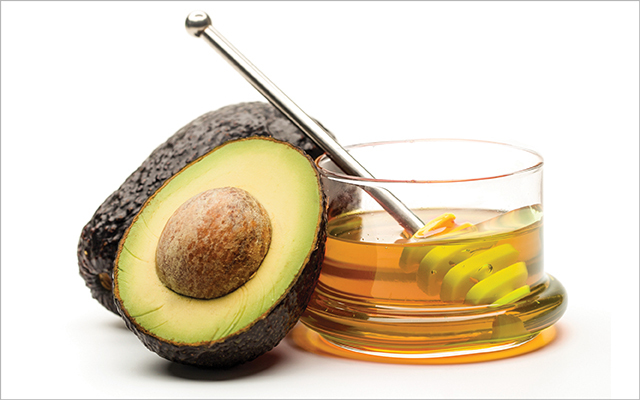Use these article shortcuts to discover how exercise makes you look and feel fantastic:
Maybe your skin looks brighter, your step is springier or you’re more confident at work. Such small victories may go unnoticed by unobservant exercisers, but those on the lookout for these benefits will find them every bit as valid as gains measured by scales and calipers.
Scientists chalk up such fitness boons to a range of powerful physiological and biochemical processes triggered by regular exercise. “Every cell in the human body benefits from physical activity,” says Tim Church, MD, PhD, the director of preventative medicine at Pennington Biomedical Research Center in Baton Rouge, La. And, he says, you feel tangible rewards right away. “Within an hour of exercising, you feel less anxious; that night you sleep better; and for 72 hours afterward your body processes blood sugar more efficiently.”
Need more incentive to lace up your sneakers? Here’s a peek into a few of the ways exercise can make you look and feel fantastic.
1. Smoother, More Radiant Skin
Genma Holmes, 43, was horrified when she broke out in adult acne three years ago. “I was 40 and felt like a hot mess because my face was dotted with pimples,” says the working mom from Nashville, Tenn. Then, last year, she started walking two miles a day and working out on an elliptical trainer three times a week. Sure, she expected to shape up, but she was shocked when her acne cleared. “Looking in a full-length mirror and seeing a slimmer me is great, but looking in a compact mirror and not seeing blackheads is even better,” she says.
Holmes’s clearer skin comes as no surprise to Audrey Kunin, MD, a dermatologist in Kansas City, Mo., and author of The DERMAdoctor Skinstruction Manual. Working up a good sweat is the equivalent of getting a mini-facial, she says. “When the pores dilate, sweat expels trapped dirt and oil. Just be sure to wash your face afterward so the gunk doesn’t get sucked back into the pores.”
“As we age, fibroblasts [the collagen-producing cells in the skin] get lazier and fewer in number,” Kunin says. “But the nutrients delivered to the skin during exercise help fibroblasts work more efficiently, so your skin looks younger.”
Breaking a sweat isn’t the only way exercise benefits the skin — it also reduces bodywide inflammation, helps regulate skin-significant hormones and prevents free-radical damage. When you exercise, the tiny arteries in your skin open up, allowing more blood to reach the skin’s surface and deliver nutrients that repair damage from the sun and environmental pollutants. These nutrients also rev up the skin’s collagen production, thwarting wrinkles. “As we age, fibroblasts [the collagen-producing cells in the skin] get lazier and fewer in number,” Kunin says. “But the nutrients delivered to the skin during exercise help fibroblasts work more efficiently, so your skin looks younger.”
For more ways exercise improves your skin, read “Exercise Makes Skin Healthier”.
2. Greater Self-Confidence
Confident people radiate a certain physical appeal and charisma. A recent British study found that people who began a regular exercise program at their local gym felt better about their self-worth, their physical condition and their overall health compared with their peers who stayed home. The best part was that their self-worth crept up right away — even before they saw a significant change in their bodies.
“You don’t need to improve your fitness level to improve your self-perception of how fit you are,” says Adrian Taylor, PhD, an exercise researcher at the University of Exeter in England and the study’s lead investigator. And from there it’s only a short leap to enjoying healthier self-esteem, he adds. “Our self-worth is directly tied to our energy levels, our feelings of competence and our perceived attractiveness.” And nothing is more gorgeous than the self-assurance that comes from feeling good in your own skin.
3. Increased Stature
Annie Appleby, 45, a yoga instructor and founder of YogaForce LLC in San Francisco, took up yoga as a means to relieve stress. But it wasn’t until she had a checkup a few years later that she saw the full effects of her practice. When the doctor measured her height, they both noticed she’d grown an inch and a half. “I couldn’t believe it,” she says. “I’d always wanted to be taller; now I fit into my clothes better and feel more spacious in my body.”
No one has studied precisely why exercise makes you taller, but activities that stretch and strengthen muscles at the same time, like yoga or Pilates, can correct bad posture and therefore add height, says Dan Bradley, MD, an orthopedic surgeon at the Texas Back Institute in Denton, Texas. Hunching makes some muscle groups contract and others lengthen, he explains, which subtracts height. “If you actively work to bring muscles back into balance, your back will lengthen, your posture will improve and you can grow taller.”
People with swayed backs benefit most from core strengthening exercises, such as planks, farmer’s walks and bird dogs. For hunched shoulders, working on strengthening the upper back using resistance with bands, machines or free weights can help restore lost height. And, of course, exercise that improves posture tends to also make you look thinner, fitter and more confident.
4. Less Stress and Anxiety
Anxiety, fearfulness and uncertainty all drain your vitality and dampen your mood, which in turn tends to show on your face and in the way you carry yourself. Roughly 40 million Americans over 18 suffer from anxiety disorders, according to the National Institutes of Mental Health — that’s nearly 20 percent of all adults — and for many of them, that anxiety strips both the smile from their face and the spring from their step. Exercise has been shown to alleviate most mild to moderate cases of anxiety, and can very quickly improve mood.
“Exercise is like taking a tranquilizer, but better because you get the side effect of improved health and fitness.”
Jack Raglin, PhD, a sport psychologist at Indiana University in Bloomington, Ind., is only half-joking when he says, “Exercise is like taking a tranquilizer, but better because you get the side effect of improved health and fitness.” Studies out of Raglin’s lab suggest that as little as 15 minutes of exercise bestows a calm that can last for hours. As for what kind of exercise elicits the biggest response, he recommends either heart-thumping aerobic exercise, like running, cycling or swimming, or a mixture of aerobic and anaerobic exercise, such as weight training.
In one study, Raglin and his team recruited 16 athletes, tested their anxiety levels, then put them through 30 minutes of resistance training and another 30 minutes of cycling. Afterward, they rechecked the students’ stress levels and found that they had plummeted within 10 minutes of wrapping up the workout and continued to decline for the next hour.
For Dorothy Foltz-Gray, 61, a writer in Knoxville, Tenn., going for a bike ride at the end of a hectic workday delivers even faster results. “I can leave my desk anxious from a day of work, grab my bike and in a few minutes have a smile on my face as I glide along a bike path,” she says. “Suddenly I’m 12 years old again, grinning at all the other bikers who grin back because they are feeling the same burst of freedom.”
5. Better Immunity and Detoxification
With spring cold season on the horizon, exercise’s immune-enhancing powers are nothing to sneeze at. Exercise shores up the immune system by goosing the body into churning out more white blood cells, including neutrophils and natural killer cells. More white blood cells mean fewer bacteria and viruses sneak past the gate. Net effect: You don’t get that worn-down sick look that comes from feeling under the weather, and small blemishes and wounds of all kinds heal faster.
Exercise also keeps the lymph system happy. The body has roughly 500 lymph nodes — little nodules of tissue that take out metabolic trash. But the nodes can’t haul garbage to the curb without the help of nearby muscles. When muscles contract during exercise, they put the squeeze on lymph nodes, helping them pump waste out of your system. Result: You look less puffy and polluted.
Increased circulation is the key to both white blood cell production and better lymph drainage, and the best way to achieve it is to regularly do things that make you breathe hard.
Increased circulation is the key to both white blood cell production and better lymph drainage, and the best way to achieve it is to regularly do things that make you breathe hard, says David Nieman, PhD, director of the human performance labs at Appalachian State University in Boone, N.C. “Right now, your heart is pumping 4 to 5 liters of blood per minute, but, if you got up and went for a run, it would pump up to four times more.”
That increased blood flow is what revs up the immune system, he says. His research shows that just 45 minutes of walking each day can cut the number of days of work you miss because of illness by up to 50 percent.
Elle Swan, 39, a life coach in Las Vegas, Nev., radiates vitality and credits her regular exercise routine —which includes Bikram yoga, group-cycling classes and weightlifting — with the fact that she hasn’t missed a day of work in seven years. “I used to catch at least four colds a year, and they would often turn into ear and sinus infections,” she says. “But I started exercising regularly and now I never get sick.”
The takeaway message, says Nieman, is simple: “There is no supplement or medication that has proven to be as strong as regular exercise in improving the immune system’s ability to detect and destroy invaders.”
6. More Restful Sleep
Plagued by dark circles? You’re not alone. As many as 60 million Americans wrestle with insomnia, according to a recent Harvard Medical School report. A slew of studies show exercise can elicit longer, more restful sleep. Why? Well, an intense workout may leave you more hungry for shuteye recovery time, but there’s more to it than that. Shawn Talbott, PhD, nutritional biochemist and author of The Metabolic Method, explains that exercise sharpens the body’s sensitivity to the stress hormone cortisol, which can enhance sleep. Sleeping better leaves you looking fresh and healthy.
Sleeping better leaves you looking fresh and healthy.
Here’s how it works: When your boss yells at you, the body spews cortisol to help muscles either duke it out or run like the wind. But, instead, if you sit and seethe at your desk, the cortisol stays in the bloodstream, like a racecar circling the track in a speedway. If the stress is chronic, the presence of cortisol 24/7 blunts the body’s cellular receptors, muting the hormone’s arousal call. That lack of sensitivity causes the adrenal glands to make more, just to get the body’s attention. “It’s like your body turns the volume up full-blast to get the message across,” says Talbott.
As a result, the body’s natural cortisol rhythms (high in the morning, low in the evening) “flatten out,” he explains, which can leave you mentally wound up at night — and carrying excess baggage under your eyes the next day.
But exercise is essentially a release valve for cortisol, helping you sleep more soundly and greet the day looking more refreshed, Talbott explains. “It sends a message to the brain that you’re using the cortisol for its original purpose — movement — and that it’s safe to turn off the tap afterward.” Bottom line: Your body is able to use the downtime for the tissue-repair work that keeps you both looking and feeling great.
7. Less Visceral Fat
Yes, exercise can help you lose your love handles, but it’s the loss of excess fat deep inside the body that boosts your overall vitality and your looks.
The body contains two types of fat. The one you can pinch (subcutaneous) is relatively benign. But the less visible stuff, the visceral fat that pads the abdominal organs like so many packing peanuts, can be a killer. Excess visceral fat fuels low-grade inflammation in the body and is tied to a virtual who’s who of 21st-century ills, including type 2 diabetes, heart disease, colon cancer, breast cancer and dementia. It can also upset the balance of important hormones (more on that to come) that affect your skin, hair and general appearance.
Regular exercise trains the body to burn visceral fat more efficiently. Exercise attacks fat on several fronts, explains Jason Karp, PhD, an exercise physiologist at Miramar College, distance-running coach at San Diego State University and owner of Run-Fit.com in San Diego. When you exercise regularly, your body makes more mitochondria, the cellular engines where aerobic metabolism takes place; it also produces more proteins to speed up the transportation of fatty acids into cells to be burned as energy; and it makes more enzymes that break down fat. “Enzymes regulate the speed at which chemical reactions take place. So the more enzymes you have, the faster visceral fat can be burned,” he adds. And the better your whole body looks as a result.
8. Stronger Sex Hormones
Getting fit not only makes you look sexy, it also makes you feel sexy by balancing the body’s sex hormone levels, which in turn can improve the appearance of hair, skin and muscle tone. Although the most studied hormones linked to exercise are endorphins, sex hormones, such as testosterone and human growth hormone (HGH — the same youth-serum substance celebrities pay thousands to be injected with), also get a boost.
When British scientists compared the hormone levels of 10 middle-aged men who ran more than 40 miles a week with 10 healthy, but sedentary, men, they found that, on average, the runners had 25 percent more testosterone and four times more HGH than the couch potatoes.
“What’s good for your heart is good for your sex life.”
“What’s good for your heart is good for your sex life,” says C. W. Randolph, MD, cofounder of the Natural Hormone Institute of America and coauthor of In The Mood Again. He points to studies showing that the sex lives of fit 60- and 70-year-olds often resemble the sex lives of people decades younger. And, remember, testosterone fuels sex drive in both men and women, so this isn’t one-sided advice.
You can tailor your workout to produce more testosterone, says Randolph. He says working large muscle groups — doing things like squats, lunges, dead lifts, bench presses and rows — ramps up testosterone more than single-joint, small-muscle-group movements like biceps curls or triceps extensions. For best results, he suggests doing three sets of five to 10 repetitions with weights that push muscles to their edge, and rest 30 seconds to two and a half minutes between sets. (For more on the sex appeal of good health, see “Health: The New Sex Symbol” and “Faked Fitness”.)
Exercise researchers agree that the benefits of improved fitness are a boon to virtually every system in our bodies. And any kind of regular activity will help you experience more of these benefits for yourself. “Most people think exercise is only about burning calories, but it’s so much more than that,” says Talbott. “Exercise is about a million small perks, like stress management, better sleep and an overall healthy body.” And they all add up to a more radiant, gorgeous you.
Knockout Nourishment
Exercise alone isn’t going to make you look and feel gorgeous — you need to pair your workout with healthy food choices. Marcelle Pick, MSN, author of The Core Balance Diet, offers these tips for how to eat beautifully.
- Eat foods rich in vitamin A. Hair, skin and nails depend heavily on vitamin A to stay strong and supple, says Pick. To up your intake, reach for more sweet potatoes, carrots, leafy greens and broccoli.
- Add omega-3s. Healthy fats help the skin retain moisture, says Pick. “When people don’t get enough good dietary fat, their skin gets dry and flaky, especially on the arms and abdomen.” Reliable sources include coldwater fish, walnuts and almonds.
- Ease up on alcohol. Being mindful of how much you drink can help keep the liver, the body’s main detoxifying organ, in tiptop shape, therefore brightening eyes and evening out skin tone. A little red wine (say 4 ounces) with dinner is fine, says Pick, but don’t overdo it — and avoid hard liquor altogether.
- Prioritize fiber. “The more veggies, fruits, beans and legumes you eat, the more efficiently your body will eliminate waste,” says Pick. The fiber in these foods helps reduce inflammation throughout the body. “And the antioxidants lower skin’s oxidative stress levels, staving off wrinkles and sun damage.” (See “Fiber: Why It Matters More Than You Think.”)
- Cut back on sugar. A high-sugar diet can feed bad bacteria in the gut and cause a low-grade inflammation that can lead to skin problems, such as breakouts and dermatitis, says Pick. Instead, try agave nectar, a (truly) natural sweetener that doesn’t spike blood sugar.
This article has been updated. It was originally published online on April 1, 2010.





This Post Has 6 Comments
Hi, I am Stefan reading your blog it’s really impressive you had put a good piece of information over here. I really appreciate the knowledge you shared with us. Keep updating such informative content.
Really like this blog, thanks for the great articles and tips.
The story of Anna Appleby motivated me to start my daily yoga practice. Thank you for a wonderful article. Keep posting such articles.
Thank you for posting on the Classy Flamingos. You’re the best.
This is nice, learned something from it.
This is a great piece of writing with a lot of useful information! I really enjoyed the way the story was presented and the writing style was very engaging. I’m looking forward to reading more posts from you in the future! Cheers!